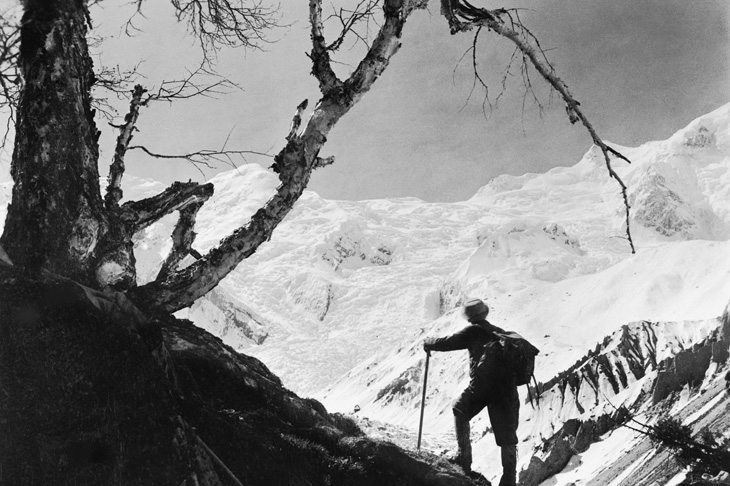A book that opens in a Lahore refugee camp, shifts to Cat Bells Fell, rising above the shores of Derwentwater, and then swoops between the Ranigunj coalfields in Bengal, Belsize Park, a handicrafts exhibition at Kharagpur, Kensington Gore, military intelligence headquarters in Calcutta, an aircraft factory in Wembley and the Himalayas is bound to keep its readers jumping. In The Last Englishmen, Deborah Baker has written an exuberant, scene-changing, shapeshifting group biography, with John Auden and Michael Spender as its chief human protagonists. But she makes the Himalayas, and Mount Everest, palpable and vivid characters in her story too.
John Auden was the geologist elder brother of W.H. Auden and became a global expert on the Himalayas. Michael Spender was the mountaineer elder brother of Wystan Auden’s fellow poet Stephen Spender. He was the chief surveyor of the 1935 reconnaissance mission to Mount Everest, and was the first to survey the northern approach to its summit.
Both men fell in love in 1938 with an artist named Nancy Sharp, then married to the talented but misogynistic painter William Coldstream and the ex-lover of the poet Louis MacNeice. Michael Spender was able to marry her just a few years before his death in a wartime air-crash. Auden meanwhile married Sheila Bonnerjee, a woman of fine-spun sensibility whose childhood reading had been Shakespeare, Browning, Tennyson and Shelley. Some of the most moving episodes in the book involve the subtle, lustrous, vulnerable Bonnerjee family, whose members had the troubled delicacy that one associates with characters in Mrs Dalloway or To the Lighthouse.
Michael Spender was an egotist with formidable powers of ruthless concentration. On an expedition to Greenland, he was so pompous and overbearing that the other explorers banded together in irrefragable dislike of him. Much the more attractive character, and really the star of The Last Englishmen, is John Auden.
Auden began his job with the Geological Survey of India in 1926. Arriving in Calcutta, he was told always to wear a solar topee, and never to befriend an Indian or to give way to any of the subject people. Within weeks he discounted his instructions. Most of what he had been told was, he realised, ‘useless or absurd, like the lines and props for a play whose run is long over’. His fear of turning into a sahib was mitigated by Wystan assuring him that consciousness of his own superiority would prevent him sinking to that level.
As a young man John Auden feared both impotence and insanity. He regularly visited whorehouses to assuage the first anxiety. To treat his incipient madness, he underwent a bastardised form of Freudian treatment from a woman named Margaret Marshall. She regarded psychoanalysis as a parlour game and held her therapeutic sessions in Paris cafés. ‘I feel safe when I am isolated and unobserved,’ Auden told her. She decided that he was too truthful to be curable. Her counter-intuitive moves were to marry him and then have an affair with their Indian manservant. If all this sounds emotionally hectic, it is.
After all the turmoil and giddying politics, it is a relief when Auden and Spender go into the Himalayas, or when Deborah Baker gives us lessons in geology. I am old enough to have had a prep school master who thought the theory of continental drift was specious nonsense concocted by a pretentious, ignorant German. I wish that Mr Buckland was alive to read Baker’s summary of the formation of the Himalayas as the indirect result of the break-up of an itinerant supercontinent known as Gondwanaland. The geological sections of this book are fascinating: every reader can become a temporary expert in fault lines, thrust blocks, fossils and rock formations. These explanations, with their clarity and mellifluous geological names, are nearly the best part of the book. They are only surpassed by Wystan Auden’s remark that being fucked by strong heterosexual young men in Weimar Berlin was like drinking Bovril — a good way to build up one’s strength.
Baker admits that it was an effort ‘triangulating’ between her three editors in Delhi, London and New York. Her sales pitch to them seems to have been that she would write a character-led non-fiction book with the colourful storytelling of a prize-winning novel. The outcome is thoughtful about human nature, original in her treatment of familiar themes and memorable when she celebrates Himalayan wonders. But she can try too hard to write like a best-selling historical novelist. There are some overwritten passages. The competing voices of her protagonists usually make a richly varied polyvocal sound; but sometimes they just make too much of a din. Baker’s facts are always straight, and everything is neatly docketed, but occasionally the variety of her characters and their conflicts comes dangerously near overwhelming. The Last Englishmen is an exciting jumble that ultimately is tidied into good sense.






Comments